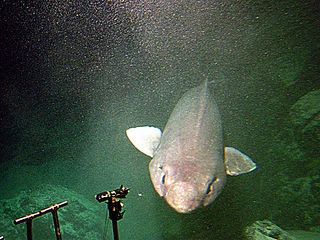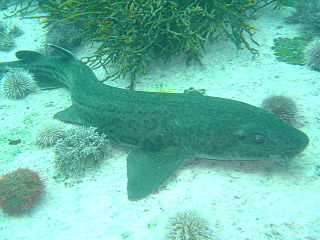
Carcharhiniformes, the ground sharks, are the largest order of sharks, with over 270 species. They include a number of common types, such as catsharks, swellsharks, and the sandbar shark.

Catsharks are ground sharks of the family Scyliorhinidae. They are the largest family of sharks with around 160 species placed in 17 genera. Although they are generally known as catsharks, some species can also be called dogfish due to previous naming. However, a dogfish may generally be distinguished from a catshark as catsharks lay eggs while dogfish have live young. Like most bottom feeders, catsharks feed on benthic invertebrates and smaller fish. They are not harmful to humans. The family is paraphyletic, containing several distinct lineages that do not form a monophyletic group.

Apristurus is a genus of catsharks, the family Scyliorhinidae, commonly known as the ghost or demon catsharks.

Parmaturus is a genus of catsharks in the family Scyliorhinidae. Four species were described in 2007 and another in 2019 with more species likely to be described in the near future.

The false catshark or sofa shark is a species of ground shark in the family Pseudotriakidae, and the sole member of its genus. It has a worldwide distribution, and has most commonly been recorded close to the bottom over continental and insular slopes, at depths of 500–1,400 m (1,600–4,600 ft). Reaching 3.0 m (9.8 ft) in length, this heavy-bodied shark can be readily identified by its elongated, keel-like first dorsal fin. It has long, narrow eyes and a large mouth filled with numerous tiny teeth. It is usually dark brown in color, though a few are light gray.
The Pseudotriakidae are a small family of ground sharks, belonging to the order Carcharhiniformes, containing the false catsharks and gollumsharks. It contains the only ground shark species that exhibit intrauterine oophagy, in which developing fetuses are nourished by eggs produced by their mother.

The pyjama shark or striped catshark is a species of catshark, and part of the family Scyliorhinidae, endemic to the coastal waters of South Africa. This abundant, bottom-dwelling species can be found from the intertidal zone to a depth of around 100 m (330 ft), particularly over rocky reefs and kelp beds. With a series of thick, parallel, dark stripes running along its stout body, the pyjama shark has an unmistakable appearance. It is additionally characterized by a short head and snout with a pair of slender barbels that do not reach the mouth, and two dorsal fins that are placed far back on the body. It can grow up to a length of 1.1 m (3.6 ft) long.

The leopard catshark is a species of catshark, and part of the family Scyliorhinidae, endemic to the coastal waters of South Africa. Abundant in inshore waters under 20 m (66 ft) deep, this bottom-dweller favors rocky reefs, kelp beds, and sandy flats. Growing to a length of 84 cm (33 in), the leopard catshark has a stout body with two dorsal fins placed well back, and a short head and tail. It is extremely variable in color and pattern, with individuals ranging from almost white to black and covered by diverse patterns of black spots, blotches, rosettes, and/or lines. The color pattern changes with age and some forms seem to be location-specific, suggesting the presence of multiple distinct, local populations. In the past, some of the more distinct color forms have been described as different species.

The bristly catshark is a cat shark of the family Scyliorhinidae, found from southeastern India and the Andaman Islands, between latitudes 15° N and 5° N, at depths between 200 and 300 m. Its length usually ranges from around 20–26 cm, and it is regarded as the smallest catshark of Bythaelurus.

The Saldanha catshark is a species of catshark, belonging to the family Scyliorhinidae. This catshark is found from Cape Columbine to south of False Bay in South Africa, between 31 and 40°S. Its length is up to 88 cm. It is a plain, dark grey-brown, stout catshark, with moderately large eyes, a broad snout, and large pectoral fins.
Bythaelurus is a genus of deep-water catsharks and part of the family Scyliorhinidae. The genus Bythaelurus Compagno 1988 was first described as a subgenus of Halaelurus Gill 1862 based on several morphological characteristics including a soft body with thin skin, a bluntly rounded snout without a pointed, knob-like tip, and eyes not noticeably elevated on the dorsal surface of the head. Members of this genus are generally found in deep water and have more somber body coloration.

The broadhead catshark is a catshark of the family Scyliorhinidae. The only specimen, the holotype, was found off Madagascar at a depth between 425 and 500 m.
The mud catshark or brown catshark is a species of catshark in the family Scyliorhinidae. It is found in Mozambique and Somalia. Its natural habitat is the open seas of the western Indian Ocean, from Mozambique to Somalia, between latitudes 13° N and 29° S, at depths between 340 and 765 m. It can grow up to 34 centimetres (13 in) long.
The jaguar catshark, also known as the Galápagos catshark, is a species of catshark from the Galápagos Islands. The species was first described in 2012. This catshark is about a foot long when mature, and it is colored blackish-brown with an asymmetrical pattern of light spots.
The dwarf false catshark is a species of ground shark, which lives in the Indian Ocean near Socotra. This species is one of two known members of its genus, the other being the pygmy false catshark off the coast of India, Sri Lanka, and the Maldives. The pygmy false catshark is very closely related to the dwarf false catshark, but has some morphological differences. Two examples are its absence of an oral papillae and that it has more tooth rows in the lower jaw.
The shortbelly catshark is a catshark of the family Scyliorhinidae. It is found in Gulf of Aden, Indian Ocean. This species most closely resembles the western Atlantic species Apristurus canutus, but is distinguishable in having greater nostril length than internarial width and longer claspers in adult males.
The pygmy false catshark, also known as the eastern dwarf false catshark is a species of ground shark, which lives in the Indian Ocean near Kochi, Kerala and off Sri Lanka. This species is one of two known members of its genus, the other being the dwarf false catshark which also lives in the Indian Ocean, but near Socotra. This had prior been an uncategorized species, but was recognized as a new species in 2019.










